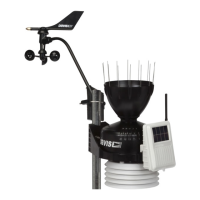
Do you have a question about the DAVIS ISS and is the answer not in the manual?
| Manufacturer | Davis Instruments |
|---|---|
| Wireless Range | 300 m (1000 ft) line of sight |
| Power Source | Solar-powered with battery backup |
| Model | ISS |
| Type | Integrated Sensor Suite |
| Compatibility | Vantage Pro2, Vantage Vue |
| Sensors Included | Anemometer, Rain Collector, Temperature sensor, humidity sensor |
| Transmission Range | 300 m |
| Mounting | Pole |
Guidance on positioning the sensor suite to avoid obstructions and ensure solar exposure for wireless models.
Instructions for setting up the ISS, noting wired systems require no configuration, while wireless systems need ID code matching.
Details on powering the ISS via solar panel or cable, with recommendations for a backup battery for continuous operation.
Explains how to set matching ID codes between the ISS transmitter and receiver for communication, detailing dip switch settings.
Describes the function of Dip switch #4 for testing the LED indicator and the importance of turning it OFF to conserve power.
